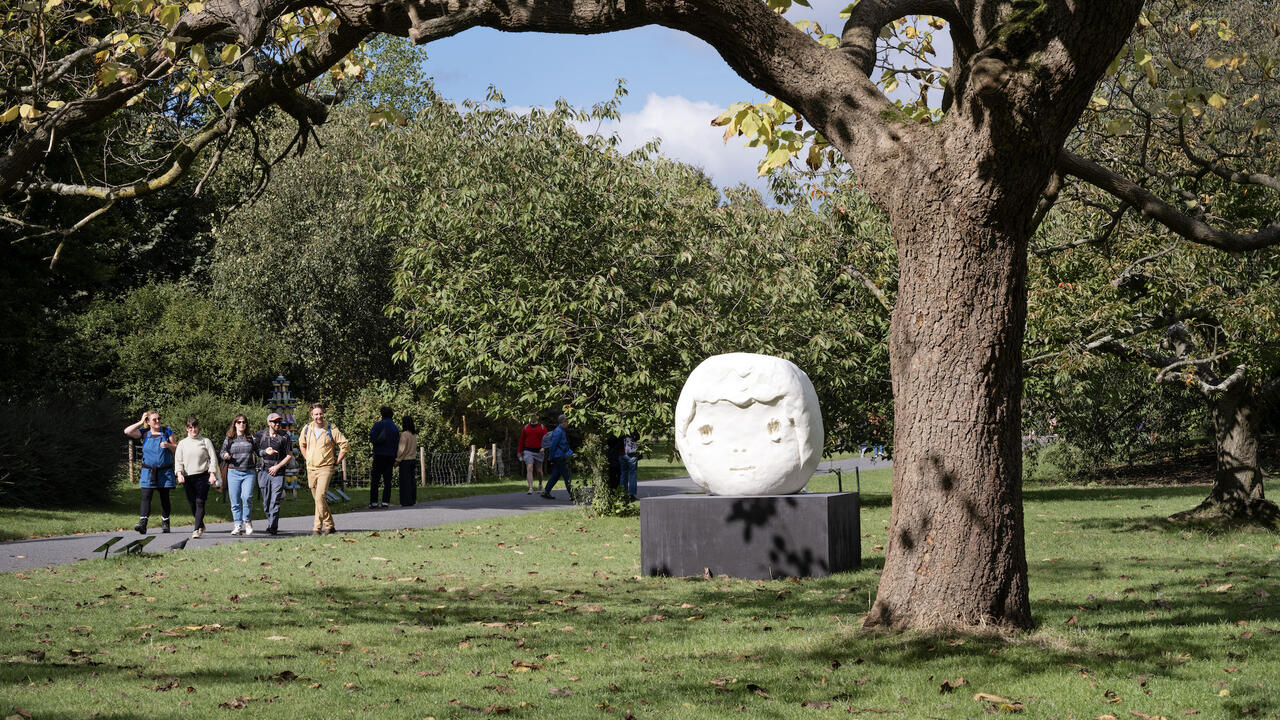Grace Schwindt Turns Illness Into A Weapon
A new installation at CCA, Glasgow, reflects on capitalism’s failure to protect even the identities it formed
A new installation at CCA, Glasgow, reflects on capitalism’s failure to protect even the identities it formed

A small work in bronze stands on a plinth at the entrance of Grace Schwindt’s exhibition. Entitled Tears (2019), the exhibition handout identifies it as ‘a solitary, suited capitalist figure – whose face is seen to melt from, merge with or prop up its body.’ This figure, sustained by its own illness, appears caught in a posture of forward-shuffling disavowal, a stilling prelude to the ensuing installation, which negotiates a personal and collective space determined by the history of illness under capitalism.
Commissioned by CCA, Glasgow and Rozenstraat – a rose is a rose is a rose, Amsterdam, Schwindt’s multi-channel video, Five Surfaces All White (2019), draws from research into The Socialist Patients Collective (SPK), a radical, militant anti-psychiatry collective from Heidelberg, Germany, active in the 1970s. Their motto, ‘Turn Illness Into A Weapon’, audaciously politicized illness, treating it not as a state of docile, passive alienation, but a site of collective struggle against capitalism, and a site of contestation within capitalism. For the SPK, illness was to be reclaimed in a positive capacity, even with performative enthusiasm.

In Schwindt’s work, the zeal of this movement fades into melancholic memory, leaving a much sadder, residual performativity. Five Surfaces All White presents a horse, a singer, a ballet dancer and an older man – bourgeois tropes – against a set of five white screens. They appear mournful, like sad reminders of capitalism’s failure to protect even the identities it formed. In the background is the misty landscape of Cove Park, where the artist retreated on the west coast of Scotland. Schwindt’s actors are captured working through movements, gestures, noises together in a way that is perhaps reminiscent of the communal patient-led techniques advocated by the SPK. The figures are filmed interacting – or attempting to and failing – making movements suggestive of a longing for contact, reciprocation and reprise, which are inevitably stalled by particular contingencies, left un-tied-up, blocked. A semi-fictionalized translation of conversations Schwindt had with her grandfather at his care home punctuates the film. Voiced by ‘the singer’ it yields a cryptic, ventriloquizing dialogue: ‘I ask him to repeat, he does but still I cannot understand what he is saying; I ask him again and again to repeat.’ Illness is shared, repeated and also impossible to share or recount.
The surrounding installation replicates and retranslates the set from within the film, with the audience positioned against five white surfaces – screens across which Schwindt’s work is projected. This linking of the characters within the film and the audience within the gallery space points to the ubiquity of a certain architectural principle both are determined by. Just as Schwindt’s characters negotiate the processes of collective choreography, the audience too is implicated as both a choreographed and choreographing element.

Fastened on one of the white surfaces in the film is a black piece of fabric – a source of intrigue for the characters, that breaks with the all-white rubric, voiced again by ‘the singer’: ‘He opens his eyes briefly and says: “Five Surfaces, all white”. He must have seen the window on the sixth wall.’ The window, far from breaking the spell of the all-white room and opening up onto the misty natural landscape, becomes a block towards its disillusion. The fabric is unpinned by one of the characters and a rectangle drawn in its place. This ‘all white’ superimposition brings to mind GK Chesterton’s metaphor for preserving the status quo: theorized in his work Orthodoxy (1908) he argues that in order for a post to remain white it must be continually re-painted white. The status quo presents itself as natural, just as whiteness presents itself as neutral, as a neutral colour within public health institutions and the architecture of corporate capitalism alike. In the film, the ballet dancer’s white dress breaks at the hemline into plumes of magneta, red, yellow and turquoise: signs of the fraying order, and a speculative possibility or memory of something different.
Main image: Grace Schwindt, Five Surfaces All White, 2019, film still. Courtesy: the artist and CCA Glasgow
























